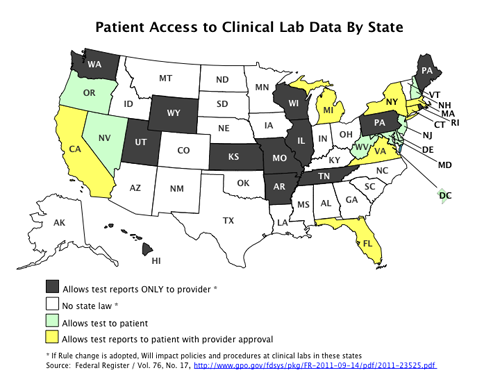Last September, the Department of Health and Human Services introduced an amendment to the CLIA Program and HIPAA Privacy Rule: Patients’ Access to Test Reports. The rule proposes that patients have unfettered access to clinical lab test reports upon request. While hospitals, clinical labs, and clinicians say they support the proposal, implementation may have its share of problems. Added costs, new processes, privacy protections, and training of lab personnel would be required to comply with the rule.
If the federal rule is adopted, it would override the current model which provides authority to the state health information exchanges who determine accessibility rules. Today, patients’ access to clinical lab information is determined by the states. The rules are, literally, all over the map. I spent the afternoon building a US map in Powerpoint of patient lab data accessibility rules thinking that I would be able to find a rational pattern across the country.
I made a few presumptions.
- Do states with strong medical lobbies only allow reports to go the the medical provider?
- There are a cluster of states in the Mid-Atlantic (DC, DE, MD, NJ, WV) that already allow patients access to lab data. Has the “open health” movement in DC had any influence on policies in neighboring or nearby states?
- Do states that have large health systems (like Kaiser Permanente in CA, OR, WA, DC, MD, and VA ) with patient portals that share data with patients already have a consistency in policies across states?
- Is there an alignment of data accessibility policies between “blue” states and “red” states?
- Is limited accessibility by patients aligned with strong statewide tort reform and medical malpractice caps?
The answers, for the most part are, “not necessarily.” In politics, it is a mistake to look for rational patterns. Politics aside, looks like the same goes for health care.
This post originally appeared on DrChrono’s Blog.

